AuthorOther rebids by opener at the 3-level and beyondGetting back on track in these 2/1 discussions, we will finish our look at opener's first rebid today. We have looked at his 2-level suit rebids and at 2NT / raise of responder suit. What is missing is new suits at the 3-level (without jumping), jumps in new suits, the jump rebid of his own suit, the jump rebid of 3NT, and higher rebids. New suit at the 3-levelWhatever is your preferred style of 2/1 (always game forcing or allowing for a one-suited invitational hand from responder), a new suit at the 3-level shows extras, and is therefore game forcing. The corollary, as discussed in an earlier article, is that the plain rebid of opener's suit (e.g. 1 Heart - 2 Diamonds - 2 Hearts) can conceal 4+ cards in the suit(s) bypassed by responder's first bid at the 2-level. The first hand, below, is too weak for bidding its suit at the 3-level after this auction (1 Heart - 2 Diamonds), and should therefore rebid hearts. The second hand is about a minimum for the 3-level new suit. We should strive to bid our suits, and so a 5-5 hand should be really vile before opener decides to conceal his second suit. The 5-4 hands have less risk, since you will be often able to bid this suit at the 3-level (after 2NT by responder), or to raise partner's side suit with 4 cards of your own if he bids it. Jumps in new suits at the 3-levelIt is feasible to play this as a strong 5-5, but it is more common to use jumps like these as splinter raises. They are game forcing (we don't want to play a part-score if opener has a nice hand in support for partner), but best used as depicting a shapely minimum. These are examples of splinter raises after 1 Heart - 2 Clubs: One big advantage of using splinter raises in this fashion is that you are able to pass 3NT by partner without being too worried that your singleton will prove to be the immediate demise of that contract. Partner should have at least 1-and-a-half stoppers to suggest 3NT. Another advantage, of course, is to help partner better judge slam prospects. Opener's jump rebidSince the plain non-jump rebid is forcing, a jump rebid should be used to depict a specific hand, giving useful information for responder's decisions. The usual way to play it is to show strength and suit quality. I suggest that it should not be unlimited (or even a max), since bidding space is at a premium after a jump. If you have, say, 17+, in other words, a hand that is basically willing to risk the 5-level after responder shows a game forcing hand, you should rebid your suit (without a jump) and later reopen the bidding. This will add definition to your jump rebid, which then becomes a good but not max hand (something like 15-16 in high cards), with an excellent suit. The excellent suit is important because you have no room for suit agreement. In other words, new suits by responder should be cuebids in support for opener's suit. You will occasionally be boxed in a corner with a 6-5 hand or something like that as responder, but not much can be done about it -- the times in which you will have a more ordinary hand and will be willing to cooperate, using cuebids, with the slam hunt are much more common. Some people suggest that the jump rebid should be a solid suit. I think that is too strict. A good compromise is to define it as a suit with zero or one loser, which can be solidified by a keycard ask. In other words: AKQJxx (solid suit), AQJ10xx, KQJ10xx, all of these qualify. AKJ10xx is up for discussion (since a queen-ask can solve it after a key-card response). But AK109xx does not. These would be examples of the bid, after 1 Major - 2 Clubs With an extra working card, the hand would be too strong to jump, in my opinion. 3NT by openerThis is a balanced hand, with stoppers, that fills in the gap in your two ranges that are shown by the 2NT rebid (the strong part of the range plans to reopen the auction). So, if you are playing that 2NT shows extras (14-15 or 18+), your 3NT rebid shows 16-17. This does not mean that any 5332 with 16-17 will rebid 3NT -- there must be adequate stoppers. In practice, when you have that strength and lack adequate stoppers, this means your suit is very good (or that your support is very good), so you won't have many problems in the auction. Jumps to the 4-level by openerThere are 4 main possibilities: 1. Jump support for partner's minor suit This shows a hand that has zero interest in playing 3NT. It is better to play it as showing a shapely 5-card support hand. So, after 1 Spade - 2 Clubs, you would bid 4 Clubs with: 2. Jump support for partner's heart suit This is a different animal, since it is not forcing. I suggest a "picture bid" approach: a hand with 4-card support and concentrated in spades and hearts, without minor suit controls. This means that you have either great spades or great hearts (not both, since you should bid 3 Hearts in this case, as all you need are good controls to have a slam). Here are two examples: 3. Jump to the 4-level in a new suit You could play this as merely a very strong splinter (stronger than the 3-level splinter), but I recommend you play it as showing specifically a void (and 4-card support, of course). Voids are incredibly powerful when the fit is good, and they should be clearly shown if possible. Some examples after 1 Spade - 2 Diamonds: 4. Jump rebid of opener's suit at the 4-level
This should not be particularly strong, since it gobbles up so much bidding space. I recommend a hand which is one trick better than a 4-level opening (preemptive) bid. Since your standards for opening at the 4-level vary (or should vary) with position, vulnerability, and even with which suit you are opening with, hearts or spades, I won't post examples. Just picture a typical 4-level opening bid for your partnership and add an extra King or Ace to the hand.
0 Comments
Leave a Reply. |
Archives
September 2021
Categories
All
|


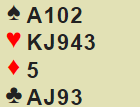



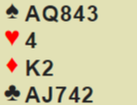
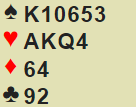
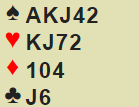

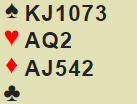
 RSS Feed
RSS Feed